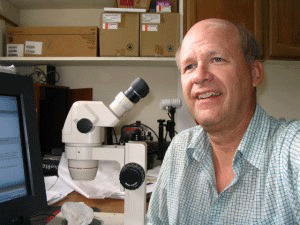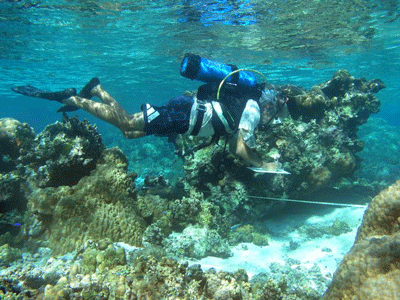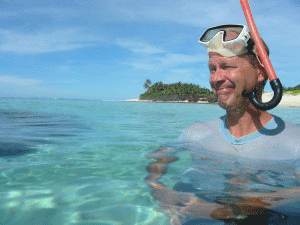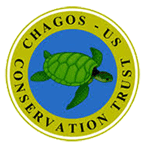Meet the 2014 Scholar – Douglas Fenner, Ph.D.

Follow Doug's progress in the 2014 CCT-US Expedition Scholar blog
Doug graduated from Reed College in Portland, Oregon with a BA in 1971, and the University of Pennsylvania in 1976 with a Ph.D. He began studying coral reefs in the Caribbean, where he surveyed reefs on several islands and published the first descriptions of the reefs around Cozumel (Mexico), Roatan, Cayman Brac, Little Cayman, and St. Lucia. He found that in order to do transects on reefs, you had to know how to identify the corals. There are relatively few coral species in the Caribbean (about 65), so it is a good place to start learning to identify coral species. Further, back then the available guide books were inconsistent with each other or with what he saw in the water, for some species. So then he studied Caribbean coral species which were shown differently in guides, and published his observations. He then became interested in the ranges of coral species in the western Atlantic, where most species are widespread around all of the Caribbean. Three species stood out as not being widespread in the Caribbean, so he gathered information from both published sources and his own records and those of others for those three species. One species, Tubastraea coccinea, had not been reported from the Gulf of Mexico, but several people had recently found it there on oil rigs. He wrote a paper on this which documented that it had spread to the oil rigs in the Gulf of Mexico. Then a colleague found it in Florida, and we found that the dates that it had been found various places showed that it was first found in Aruba and Puerto Rico, and then spread gradually around the Caribbean, reached the oil platforms in the Gulf of Mexico, and finally spread to Florida.

Doug then began studying corals in Hawaii, and found several species there that had not been previously reported. All of the coral species in Hawaii are different from in the Caribbean, so he had to learn all of these new species. In time, he collected photographs of the coral species in Hawaii, and wrote an identification guidebook to the corals of Hawaii, entitled “Corals of Hawaii” which was published in 2005.
Doug joined an expedition to Belize with a British NGO named “Coral Cay Conservation”, and spent 3 months there, teaching volunteers to identify corals and how to survey, and directing surveying reefs. Coral Cay Conservation surveys reefs to provide information to governments and local groups to aid in the process of setting up MPAs by finding good reef areas for MPAs. Then Doug went to the Philippines, to help Coral Cay Conservation start surveying reefs around a small island. Later he was hired by a European-Union funded project that was surveying reefs in the Philippines to aid the process of setting up MPAs. Doug likes to work on conservation projects like these, because coral reefs are fabulous fascinating ecosystems, which provide people with many valuable ecosystem services, and people have damaged them and they are highly threatened by future climate change. The diversity of corals in the Philippines is amazing if not overwhelming, so it was a great place to learn to identify hundreds of species of corals. He also recorded coral species in about 20 areas of the Philippines.
Doug was then hired by one of the world’s top coral taxonomy experts, Dr. “Charlie” J.E.N. Veron, at the Australian Institute of Marine Science in Townsville, Australia. Doug’s job was to author an electronic key to the coral species of the world, based on the book which Veron was writing on corals of the world. The book was published in 2000, and the electronic key was released a few years later. Doug worked for Charlie for 6 years. During those 6 years, Doug joined Charlie in several rapid surveys of reefs in the Philippines, Indonesia and Papua New Guinea by teams led by Conservation International, recording coral species.
 In late 2003, Doug was hired by the Dept. of Marine & Wildlife Resources in the territorial government of American Samoa. Doug was a coral reef monitoring ecologist, designing the benthic portion of the American Samoa monitoring program. Doug did that monitoring for 9 years, producing reports of about 100 pages of the results each year. In addition, he took pictures of coral species and many other benthic organisms and collected samples. He has written a guide in pdf form to identification of organisms in American Samoa for coral reef monitoring. This guide includes sections on how to recognize bleaching, predation, and coral disease. The guide includes as many or more coral diseases than are currently known for the entire world. He’s also written a pdf identification to the genera of hard corals in American Samoa, and a pdf identification for 156 coral species. In the near future he hopes to expand this guide to 200 or perhaps even 250 species. He has also begun writing a taxonomic monograph on the corals of American Samoa, based on the samples of coral species which he collected. During his 10 years in American Samoa, he has also participated in rapid surveys in places such as New Caledonia, the Andaman Islands, Madagascar, Rodrigues (Mauritius), and most recently Nauru and then Tonga. In every survey, coral species that had not previously been reported at that location were found, sometimes as many as 70 species. Doug can identify as many as about 450 species of corals around the world. The data Doug gathers will be comparable to the data he has collected around the world at over 800 dive sites.
In late 2003, Doug was hired by the Dept. of Marine & Wildlife Resources in the territorial government of American Samoa. Doug was a coral reef monitoring ecologist, designing the benthic portion of the American Samoa monitoring program. Doug did that monitoring for 9 years, producing reports of about 100 pages of the results each year. In addition, he took pictures of coral species and many other benthic organisms and collected samples. He has written a guide in pdf form to identification of organisms in American Samoa for coral reef monitoring. This guide includes sections on how to recognize bleaching, predation, and coral disease. The guide includes as many or more coral diseases than are currently known for the entire world. He’s also written a pdf identification to the genera of hard corals in American Samoa, and a pdf identification for 156 coral species. In the near future he hopes to expand this guide to 200 or perhaps even 250 species. He has also begun writing a taxonomic monograph on the corals of American Samoa, based on the samples of coral species which he collected. During his 10 years in American Samoa, he has also participated in rapid surveys in places such as New Caledonia, the Andaman Islands, Madagascar, Rodrigues (Mauritius), and most recently Nauru and then Tonga. In every survey, coral species that had not previously been reported at that location were found, sometimes as many as 70 species. Doug can identify as many as about 450 species of corals around the world. The data Doug gathers will be comparable to the data he has collected around the world at over 800 dive sites.
Doug has also published the most extensive review of coral reef fisheries, and papers on other coral reef subjects. He is a frequent contributor to the “coral-list” discussion online, subscribed to by over 7000 people who work on coral reefs around the world.
Doug hopes to survey, record, and photograph coral species and coral diseases in Chagos and will be keeping us all involved through his blog. Hopefully he will be able to find or identify some species which have not been found there before, as well as coral diseases not reported from there as well. It will be interesting and important to gather data on the diversity and prevalence of coral diseases in this archipelago that has low levels of human impacts. The low level of human impacts suggests that it may have low levels of disease. Doug will be working with Dr. Courtney Couch as a team, recording coral disease and its prevalence. It is important to both get baselines for the number of coral species and coral cover, but also for coral disease diversity and prevalence. We know far too little about what reefs are like where there has been little human disturbance. Reefs that have had little or no human impact are our best way to measure how much we have lost on most of the world’s coral reefs. In addition, coral reefs face a very threatening future, when climate change is sure to cause a great deal of coral mortality. We must gather the data to know what natural reefs are like, before they are damaged, so we know how much they change in the future.

 Chagos Conservation Trust – US
Chagos Conservation Trust – US